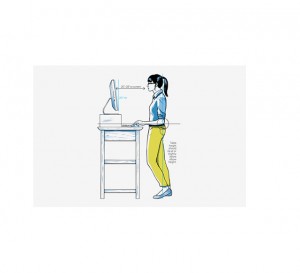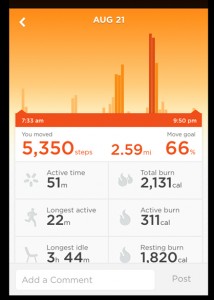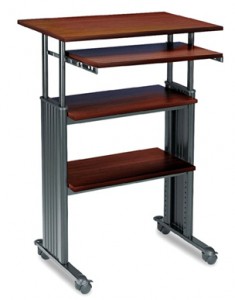Five or more hours of sedentary sitting, according to researchers, is the health equivalent of smoking a pack and a quarter of cigarettes.
Yet sitting around is something we get plenty of practice at.
Reading and writing and creating on a computer makes for big chunks of sedentary time.
If you’re reading this post right now, are you sitting down?
How long have you been sitting?
It’s a topic that I think of more often these days.
Eye health and general health all need a break from the computer and yet in pharmacy environments we have not fully caught up on our occupational health.
Certainly, the use of dispensing computers is performed in a standing position (the now recommended method for all computer use) and this gives a clue as to why as a profession, pharmacists were generally a more healthy bunch in the past.
That is until the PBS treadmill added a layer of stress that reversed all the healthy aspects.
But we have yet to adapt all of the health negatives in computers to a work day schedule that involves regular breaks and how we focus on exercise and movement.
Some years ago the Japanese led the way by incorporating exercise into the work day in a structured format.
The western world thought it all a bit odd until Japan began to emerge as a powerhouse economy, the envy of all other economies.
So it’s really about time that those involved in workplace activities and regulation, should begin to look at an average working day for pharmacy staffs and see if a positive health aspect can be built into it.
We know standing at a computer is healthier than sitting in front of one, so that is a good start.
However, senior pharmacists and assistants are the first to feel the effects of workplace “standing” and are stoic enough not to complain, lest that be used against them when it comes time for a performance review, when one of the measurements becomes scripts processed or checked per hour.
Do we lose the experience of these people permanently or do we devise a method of taking them out of the prescription treadmill in a structured manner and give them lighter duties that have a stronger social and “sitting down” component so that their experience is valued and put to good use.
And their jobs are preserved because senior people tend to be more stoic and not reveal the stresses their muscles and joints are incurring, preferring to resign or retire, knowing that management will not necessarily be adapting the workplace to suit “seniors”.
I am thinking of mentoring duties, particularly where management may be trying to delegate some complex work activity further down the line management chart.
Not only would this be a good management style, but as delegations began to take effect, productivity would result.
Certainly the work would become more interesting because the people receiving delegations would, in fact, be the ones receiving promotion and eventually receiving a title (either a title that exists or a new title that has to be created because the business has expanded and become more complex).
Productivity increases not only generate the time to allow for mentoring, but increases the profit base because of increased efficiencies in business processes.
Mentoring also requires more social interaction so work in general becomes more pleasurable.
Senior pharmacy staff is the repository of how pharmacy was conducted in times past. This is also important, as mentoring involves the telling and re-telling of “stories” which are an essential component of mentoring.
As they say “history repeats itself and the lessons of history are not always learned by current managers”. Once knowing how things were once done provides a reference point for what did work – something that can be absorbed into today’s context and revised with new technology input.
As the computer rules most workplaces what is indeed the healthiest way to work?
And what can you change about your style today to get the biggest benefit?
So what can be incorporated into sedentary workplaces for a healthier workforce?
1. Studies have shown that our bodies can benefit from simply standing up, contracting muscles, and moving. Think of standing as pushing a reset button on your body. If you press the reset button before the timer hits 20 minutes, you’ll avoid any of the negative side effects of a sedentary job.
New science shows very persuasively that standing up about every 20 minutes, even for only a minute or two, reduces your risks of developing diabetes and heart disease.
By standing up, you cause the big muscles in your legs and back to contract, which leads to an increase in certain enzymes that break up fat in the blood stream. You don’t have to jog in place or do jumping jacks. Just stand. A very pleasant additional benefit is that standing up every 20 to 30 minutes also seems to prompt the body to burn calories, so you don’t gain as much weight from sitting at the office most of the day.
If you can stand up every 20 minutes — even if you do nothing else — you change how your body responds physiologically.
Other studies confirm the benefit of this simple act of standing. For instance, a study of employees at New Balance shoe headquarters showed that performing an activity every 30 minutes—standing, walking, stretching—improved not only health but also engagement and concentration.
Similarly, those people who have been standing for an extended period now need to be able to sit.
Somehow, some of the work that the “sitters” do needs to be exchanged for the work done by the “standers”.
This would create different forms of delegation and provide a more multi-talented workforce if good job exchange principles were employed by management.
So now the question becomes: How do you stand up every 20 minutes?
The answer may be found in some of the mobile phone apps that appear almost on a daily basis and will check a wide variety of activity.I am suggesting that this approach be a more personal one and not be mandated by management. It could also be coupled with some “privilege time” where an employee can respond to personal messages and texts while measuring worktime activity.
The illustration below is called “UP Band” because it relies on a wearable wrist band to transmit data to a special app program contained within a smart phone.
The system illustrated is only one of many fitness-type solutions, but do your own research to see if there is one more suited for your purposes.
Whatever the outcome you need a more fluid workplace in a 21st century pharmacy, because the existing model has lost its “connectiveness” and is not a very happy place to work in.
With reference to the app below:
Those big, flat valleys are exactly the types of inactive stretches it’s best to avoid.
Solution: The UP band lets you set a move reminder that causes your wristband to buzz after a certain amount of inactivity. Bingo! Set it to 20 minutes, and stand up when it buzzes.
Other fitness bands offer similar functionality, too. And if you’d prefer to keep things super straightforward, you can go with a trusty phone or kitchen timer to set a manual notification for yourself.
2. Change the area worked in.
This may not always be possible in a small pharmacy, but exchanging the dispensary for the accounts office or the store room to assist in inventory planning, or relocating to the “forward pharmacy” station may provide the stimulus that keeps positivity going.
If work is planned in advance for these different work stations, then productivity indeed can begin to blossom at all levels as each new “eye” creates a different interpretation as to how work within those stations can be improved.
Simple stretching exercises can also be routinely incorporated as the standing must always be accompanied with movement for maximum benefit.
3. How to find the right standing desk
Perhaps the most obvious (and increasingly popular) idea of how to stand and move more at work is to convert your workstation with a standing desk. If you’re curious to try this for yourself, all the best advice is to start small and cheap. And take things slow.
Small and cheap is the best way to start because you don’t want to pay big dollars for something you don’t like and therefore might not enjoy using. High-end standing desks can cost over $1,000. Therefore, it’s best to give a standing workstation a trial before you commit to a steep price tag.
First things first, posture is essential no matter what desk you use. Here’s a helpful graphic from Wired about the appropriate height, distances, and angles for a standing desk.
- Monitor should be 20-28 inches away from your eyes with the screen at a 20-degree tilt
- Table height should be at or slightly below elbow height
- Elbows at a 90-degree angle to the keyboard
- Eyes looking slightly down to the monitor

You’ll notice that this type of setup gets a little difficult with a laptop because the keyboard and screen would be on the same level. If you plan on a standing desk for your laptop, it might be best to invest in a standalone keyboard and mouse so that you can adjust your screen and peripherals to the ideal height.
As for the desk itself …start with a fixed-height standing desk
In the spirit of starting small, the fixed-height standing desk should come first.
The advantages of an adjustable desk are likely to be noticed immediately: you can vary the height at which you work when sitting, standing, or moving in between. For the best standalone adjustable desk you are liable to find the design illustrated below will suit best.
Move while you sit: Buy an active desk chair
Along with a standing desk, a supplement to moving more while you work is to find an active desk chair that supports constant movement and good posture. Even those who opt for standing at work find that it’s best not to stand all day; a 70:30 split of standing to sitting is often best.
The following chairs can help. These adjustable stools and seats can fit either workstyle—standing or sitting—and they support constant movement throughout the day by being just unstable enough to keep your muscles in motion.
Active couch potatoes: How does daily exercise help?
In a study of marathoners, researchers found that participants trained an average of 65 Km per week, which is enough exercise to place them among the most active adults. At the same time, these runners sat idle for nearly 12 hours per day.
Hence the term “active couch potatoes.”
Interestingly, studies have shown that idle sitting (e.g. sedentary work) is an independent predictor of disease, meaning that daily exercise before or after work does not cancel out a day of sitting in front of the computer.
Of course, daily exercise can help in many other ways and an active couch potato is better off than a regular coach potato. Yet it would appear that a chunk of exercise is not enough to counteract the effects of a sedentary job. Consistent, regular movement is best.



One response to “Workplace Changes Needed to Upgrade Employee Health”
An important article. We spend many hours in our workplace and this can impact on long term health and well-being. In the same way that we invest in a good bed or a comfortable chair at home it is important to invest in a good quality ergonomic work environment.